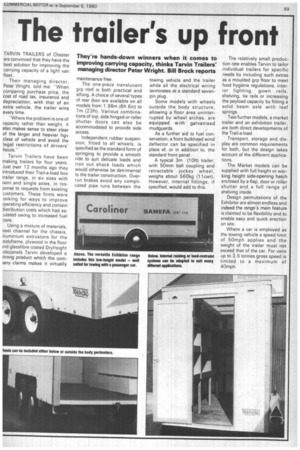The trailer's up front
Page 71

If you've noticed an error in this article please click here to report it so we can fix it.
TARVIN TRAILERS of Chester are convinced that they have the best solution for improving the carrying capacity of a light van fleet.
Their managing director, Peter Wright, told me: -When comparing purchase price, the cost of road tax, insurance and depreciation, with that of an extra vehicle, the trailer wins every time.
"Where the problem is one of capacity rather than weight, it also makes sense to steer clear of the larger and heavier hgv class of vehicle and avoid the legal restrictions of drivers' hours."
Tarvin Trailers have been making trailers for four years. Just over 12 months ago they introduced their Trail-a-load box trailer range, in six sizes with twin and single axles, in response to requests from existing :ustomers. These firms were ooking for ways to improve )perating efficiency and contain distribution costs which had es:ulated owing to increased fuel :osts.
Using a mixture of materials, ;teel channel for the chassis, iluminium extrusions for the )odyframe, plywood in the floor ind glassfibre coated Dryfreight idepanels Tarvin developed a ;trong product which the cornany claims makes it virtually maintenance free.
The one-piece translucent grp repot is both practical and strong. A choice of several types of rear door are available on all models from 1.98m (6ft 6in) to 7m (23ft). Various combinations of top, side hinged or roller shutter doors can also be accommodated to provide side access.
Independent rubber suspension, fitted to all wheels, is specified as the standard form of springing to provide a smooth ride to suit delicate loads and iron out shock loads which would otherwise be detrimental to the trailer construction. Overrun brakes avoid any complicated pipe runs between the towing vehicle and the trailer while all the electrical wiring terminates at a standard sevenpin plug.
Some models with wheels outside the body structure, allowing a floor area uninterrupted by wheel arches, are equipped with galvanised mudguards.
As a further aid to fuel conservation, a front bulkhead wind deflector can be specified in place of, or in addition to, the standard front panel.
A typical 3m (1 Oft) trailer, with 50mm ball coupling and retractable jockey wheel, weighs about 560kg (11 cwt). However, internal fittings, if specified, would add to this.
The relatively small production rate enables Tarvin to tailor individual trailers for specific .needs by including such extras as a moulded grp floor to meet food hygiene regulations, interior lighting, gown rails, shelving, tie rails or increasing the payload capacity by fitting a solid beam axle with leaf springs.
Two further models, a market trailer and an exhibition trailer, are both direct developments of the Trail-a-load.
Transport, storage and display are common requirements for both,. but the design takes account of the different applications.
The Market models can be supplied with full height or working height side-opening hatch enclosed by a flap, door or roller shutter and a full range of shelving inside.
Design permutations of the Exhibitor are almost endless and indeed the range's main feature is claimed to be flexibility and to enable easy and quick erection on site.
Where a car is employed as the towing vehicle a speed limit of 50mph applies and the weight of the trailer must not exceed that of the car. For vans up to 3.5 tonnes gross speed is limited to a maximum of 40mph.




































































































































